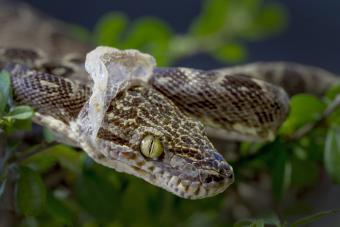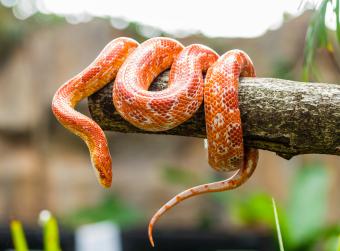
One of the most fascinating things about snakes is their ability to shed their skin. Shedding allows snakes to get rid of old and damaged skin, protecting them against parasites and rejuvenating their outer layer. How often do snakes shed and how do you know when shedding is abnormal? Keep your snake happy and healthy by learning more about their natural process of growth.
Why Snakes Shed Their Skin
When a snake sheds its skin, it's different from how we constantly shed our top layer of skin. We "shed" all the time, but snakes do it all at once.
Instead of constantly losing skin cells, like humans, snakes peel off their old skin at one time and replace it with a new skin underneath to provide room for growth. As snakes get older, their bodies outgrow their old skin and it no longer fits them properly.
It's kind of like how we outgrow our clothes and need new ones as we get older. Your toddler can't wear those 2T pajamas forever. Eventually, they'll need a bigger size. It's similar for snakes. Eventually, like us, their growth will slow down. Even when we're grown, we still need to change our clothes, but not as frequently as when we were toddlers.

Signs Your Snake Is Going to Shed
The signs of shedding begin about a week before the actual shedding process:
- Your snake's eyes look a little duller than usual and begin to cloud over.
- Your snake's skin looks dull and feels dry and rough to the touch.
- Your snake is rubbing against anything available - rocks, branches, or even your hands!
- Your snake has left behind bits of shed skin around their enclosure - especially under rocks and logs where they prefer to hide out during shedding season!
Snakes rub against things during shedding because they're trying to loosen old skin from their bodies so they can shed more easily.
The Shedding Process
When it's time for a snake to shed their old skin, you will notice small stress lines appearing on the snake's body as the new layer of skin emerges from under the existing layer. The old outer layer begins to wrinkle up and crack open at the head of the snake. The loosened skin will then begin to peel off from the head down towards the tail end--or unevenly, depending on several conditions--starting at one side and working its way across towards the other side.
Your snake's skin will either continue to shed down the length of their body in one piece or in pieces while they are rubbing against objects in their terrarium. This process can take anywhere from days up to two weeks, depending on where you live and what type of snake it is.
Do not try to help your snake shed. If you interfere, you will likely break their new skin and cause your snake to bleed. Helping your snake shed could also lead to bacterial infections or other health conditions. Allow the natural process to occur on its own and only observe during this process.
Snakes will stop shedding if they're stressed out by something, such as being moved or handled too much.
How Your Snake Sheds
There are two different ways that snakes shed their skin:
- In one piece: Snakes that shed their entire skin at once usually have smooth scales on their bodies. If your pet has smooth scales, don't be alarmed if the snake sheds in one piece! It's normal for some species of snakes to do this.
- In pieces: Most snakes have keeled scales on their bodies, which are rough bumps running down the length of their backs, but some species have smooth scales instead. For example, corn snakes have smooth scales, while ball pythons have keeled ones. Therefore, the corn snake is more likely to have a shed that comes off in one piece.

Abnormal Shedding
Abnormal shedding in snakes is a common problem with many causes. The most likely cause is stress, which is usually due to not receiving adequate heat or humidity levels, or if their environment is too cold or too hot. Review your snake's requirements. Each snake is different and requires different temperature and humidity ranges.
There are also parasites that can cause abnormal shedding, as well as infections and other illnesses. For example, a snake mite infestation could cause your snake to be unable to shed properly. Also, if your snake has been shedding multiple times per year without any real signs of growth, it could be an indication of an underlying health issue.
If you have a snake that is exhibiting abnormal shedding, the first thing you should do is take them to the vet for a checkup. If there are any other symptoms like severe lethargy or regurgitating their meals, this is an emergency, and you should take the snake in right away.
Preventing Problems for Your Snake
Snakes need to keep their skin clean and moist in order to shed properly. If a snake's skin gets dry or cracked, it can make shedding difficult or even impossible. To help your snake shed properly, the best thing you can do is make sure their environment is set up and maintained correctly.
- Keep the humidity level within the appropriate range in your snake's enclosure. This will help keep the skin moist and flexible during shedding.
- Make sure that there are plenty of hiding places for your snake to retreat into while it sheds its skin. Snakes are vulnerable to predation during shedding periods and will feel more comfortable if they're able to retreat during this time.
- Wipe down the inside of the enclosure with warm water once or twice a week to keep any loose dirt or debris away from the snake's eyes and mouth area.
- Many species of snakes will lounge in their water bowl just before they begin shedding. This is normal, so just remember to keep your snake's water bowl filled with clean, fresh water to support them through the process.

Fast Facts About Snake Shedding
Every snake is different, and you will need to understand your snake's species to know what's normal for them.
- Many snakes shed just after they go through a dormancy phase, usually when temperatures outside drop down and their metabolisms slow.
- They'll shed more often if they are in an environment that is too dry or too hot, not getting enough food or water, or if they're stressed out by something around them.
- Since snakes don't have eyelids, they can't close their eyes if something gets on them during the shedding process.
- Prior to shedding, you may notice your snake becoming less active and not eating. That is completely normal.
- Because they are growing, younger snakes typically shed more frequently than adults of the same species.
- Some species shed more often than others. For example, adult corn snakes shed once every three months, while boa constrictors shed only once every six months or so.
The most important thing to remember is not to interrupt this process or disturb your snake while they're shedding. Molting is a normal bodily function for your snake, and all you need to do is support them by maintaining their setup and keeping them healthy.
Let Them Shed on Their Own
Shedding is normal for your snake and is generally nothing to worry about. Most snakes shed their old skin as they should and don't experience any issues. If you do notice abnormal behavior, excessive shedding, or a lack of shedding, you may need to contact your veterinarian.







